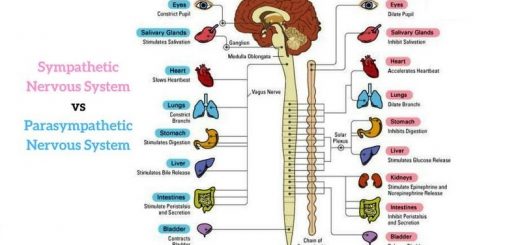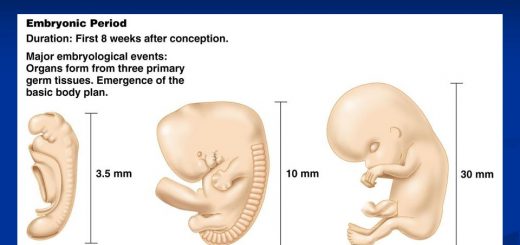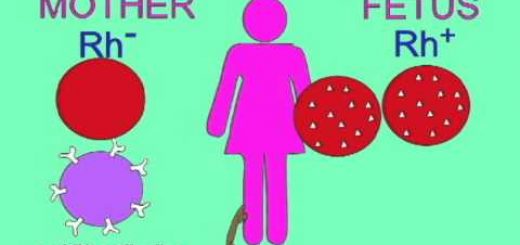Fertilization process, Pregnancy and the stages of embryonic development
Fertilization is the fusion of the male gamete (sperm) with the female gamete (ovum) to form the zygote which divides to form the embryo, The man may be considered infertile, if the number of sperms is less than 20 million sperm per ejaculation, because many of them are lost during their journey to the ovum and the dissolve of a part of the ovum coat which is intact by hyaluronic acid requires the presence of a large number of sperms.
Fertilization
The ovum is released on the 14th day from the beginning of menstruation and it is ready for fertilization within 1-2 days, Fertilization takes place in the anterior third part of the Fallopian tube, The number of sperms ranges between 300-500 million sperm per ejaculation, where many of them are lost during their journey to the ovum, The sperms can stay alive about 2-3 days inside the female genital system.
All the sperms participate together in secreting the hyaluronidase enzyme which dissolves a part of the ovum coat that is intact by the hyaluronic acid, One sperm only enters into the ovum by its head and neck, leaving the midpiece and tail outside, After the fertilization process, the ovum surrounds itself with a coat that prevents the entrance of any other sperms.
Pregnancy and embryonic development
After one day from fertilization: The zygote divides by mitotic division into two cells (two blastomeres) at the beginning of the Fallopian tube.
After two days from fertilization: The two cells are multiplied to four cells, The cellular division is replaced, forming a mass of small cells known as the morula which is pushed along the Fallopian tube by the action of cilia, till it reaches the uterus.
The endometrium is characterized by a blood supply that is necessary for the development of an embryo during the nine months of pregnancy, In the uterus, The morula is implanted among the folds of the thick-walled uterus (the endometrium) at the end of the first week.
The rate of embryo growth increases and organogenesis and tissue differentiation take place gradually, Two embryonic membranes are formed around the embryo, The embryonic membranes include two membranes which are the outer chorion and the inner amnion.
Amnion membrane is a membrane that surrounds the embryo and contains a fluid to protect the embryo against shocks or dryness, Chorion membrane is a membrane that surrounds the amnion membrane to protect the embryo.
There are finger-like projections that grow from the chorion membrane that is inserted in the endometrium and in which the blood capillaries of both the embryo and mother touch each other, They intermingled, forming the placenta.
The importance of the placenta
- It transfers the digested food, water, oxygen and vitamins from the mother’s blood to the embryo’s blood by diffusion.
- It gets rid of the embryo’s excretory wastes without mixing the embryo’s blood with the mother’s blood.
- It secretes progesterone hormone at the beginning of the fourth month of pregnancy because the corpus luteum degenerates, Therefore, the placenta becomes the source of secretion of the progesterone hormone.
- It secretes the relaxin hormone that plays a role in the relaxation of the pubic symphysis at the end of pregnancy to facilitate the process of delivery.
The placenta transfers drugs and harmful substances such as alcohol, nicotine and viruses from the mother’s blood to the embryo which causes acute harm, serious deformities and diseases to the embryo.
The embryo is connected with the placenta by a tissue that is rich with blood capillaries called the umbilical cord whose length is about 70 cm to allow the embryo to move freely.
The importance of umbilical cord
- It transfers the digested food, vitamins, water, salts, and oxygen from the placenta to the embryo’s blood circulation.
- It transfers the excretory wastes and carbon dioxide from the embryo’s blood circulation to the placenta.
The stages of embryonic development
The period of embryonic development is divided into three stages which are as follows:
The first stage
It includes the first three months of pregnancy, where: The nervous system and heart start their development (in the first month), The hands and eyes become differentiated, The two sexes become differentiated, as the testes develop in the 6th week, while the ovaries develop in the 12th week, the embryo becomes able to respond to the stimuli.
The second stage
It includes the middle three months of pregnancy, where: the development of the heart is completed and its beats can be heard, Ossification of the skeletal system takes place, The sense organs are completed, the growth of the embryo in size increases.
The third stage
It includes the last three months of pregnancy, where: The development of the brain is completed, The development of the other internal systems is completed, and the growth of the embryo in size slows down.
Productive organs, Germ cells, Fertilization, Stages of cleavage, Implantation and Decidua
Fetal membrane layers, Chorion, Amnion, Yolk sac and umbilical cord
Structure of Female genital system & ovum, Oogenesis stages and Menstrual cycle
Reproduction in Human being, Structure of Male genital system and sperm
Childbirth, lactation, types of twins, problems related to childbearing and gametes banks
Placenta types, structure, function, development & abnormalities



